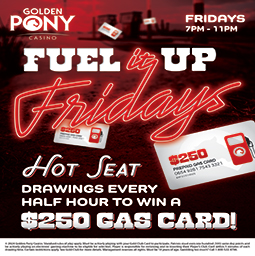Henryettans from 1925 through 1969 remember him facing east in the middle of the Fourth and Main intersection. We were proud of him. And if someone had trouble recalling Henryetta, we could mention him and they'd remember, or if we just mentioned Henryetta, they might say "Oh, that's where the soldier statue is."
He was a convenient place to meet friends, and making a left turn around him was the most feared part of teenage driving tests. But he was in the way. Bands, floats and other groups had to get past him in parades. Intercity busses, trucks, even World War II army convoys, used Trudgeon or Broadway to avoid dealing with him. But he was still "our" Doughboy, and we were proud of him. My friends and I didn't wonder if he had a proper name other than "The Doughboy", when or how he got there, or who his sculptor was. And most, including me, assumed he was one of a kind. Well, he has a proper name and had a sculptor. It took a lot of effort by Henryetta citizens of the time, including many World War Veterans, to raise funds, acquire him, and dedicate him.
And he isn't one of a kind.
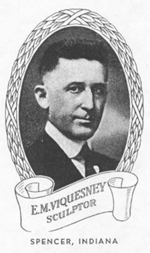 His proper name is “The Spirit of the American Doughboy” and the sculptor was Ernest Moore (Dick) Viquesney (1876-1946). He created the statue during the late stages of World War I in Americus, Georgia, and ours is one of about 145 in the country. I say "about" because there are many ways of counting them. Do replacements of destroyed ones count? Do both the replacement and its predecessor count?
His proper name is “The Spirit of the American Doughboy” and the sculptor was Ernest Moore (Dick) Viquesney (1876-1946). He created the statue during the late stages of World War I in Americus, Georgia, and ours is one of about 145 in the country. I say "about" because there are many ways of counting them. Do replacements of destroyed ones count? Do both the replacement and its predecessor count? Do those that were destroyed and never replaced count? Do those that have been moved from one town or city place to another count in both places or just one?
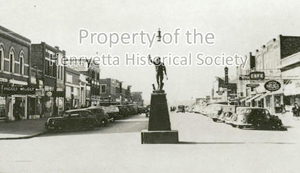 When it was originally placed in Henryetta, the statue stood at the intersection of Fourth and Main.
When it was originally placed in Henryetta, the statue stood at the intersection of Fourth and Main.In the 1990s and the early 2000s, Les Lopel of Oxnard, California and I worked together to locate all of the Viquesney Doughboys in the country.
It was an exhaustive task since there were no reliable records of where they were placed and even the Smithsonian had many erroneous listing and also omitted just as many. Along the way, we learned Viquesney also created a companion "The Spirit of the American Navy' that accompanies the Doughboy in seven locations. Les and I have a very complete website that gives extensive information about the statue and its many locations. For those with computers, it can be accessed at http://doughboysearcher.weebly.com/.
Now for some information regarding the acquisition of Henryetta's Doughboy.
June 7, 1923, forty World War (now called “World War I”) veterans met at the old Henryetta City Hall with Morris Adler and A. C. Goree, local American Legion and VFW post commnders, and decided to erect a monument of an American doughboy in a small park in Buena Vista on Armistice Day, November 11.<br/They chose Viquesney's "The Spirit of the American Doughboy" statue of a soldier striding through a stumped and barbed wired "no man's land" in puttees and full field equipment with a bayoneted rifle in his left hand and a grenade in his raised right hand. Acquisition funds would be raised by public subscription.
The first funds were raised when the veterans operated a concession stand and adjacent "hoose-gow' at the corner of Fifth and Main during the July 2-4 King Koal Karnival. In addition to selling concessions, "military police" patrolled the area and put officials and other dignitaries in a barb wired stockade for whatever reason they cared to invent, and required deposits to the monument fund for their release.
September 21, the veterans decided that instead of placing the statue in Buena Vista park, it'd be placed in the middle of Main Street between Fourth and Fifth Streets, and also decided to hold a local talent show to raise more funds on October 18 at the Morgan Theater, whose manager, Charles Blaine, had offered its use.
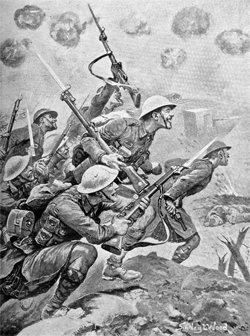 The talent show was a standing-room-only success. A silent war movie, with Dick Klein at the piano, was followed by a short address by Mayor Orendorff. Talent acts followed. First was a a squad of doughboys portraying being ready to go "over the top." Next was an old timers fiddler contest. "Cyclone Billy" Baker, 133 pounds, then boxed three humorous rounds with Chief Hepworth, 197 pounds, and Frank Hoffman did a fancy rope act.
The talent show was a standing-room-only success. A silent war movie, with Dick Klein at the piano, was followed by a short address by Mayor Orendorff. Talent acts followed. First was a a squad of doughboys portraying being ready to go "over the top." Next was an old timers fiddler contest. "Cyclone Billy" Baker, 133 pounds, then boxed three humorous rounds with Chief Hepworth, 197 pounds, and Frank Hoffman did a fancy rope act. Then, Chigger Weights Mysterious Elsworth and Kid Stroup stepped four rounds. Barney Jameson (later long-time Cub leader) did his comedy act pulling gags, and dedicated his vocal, "Our State is Clean" to Henryetta coal operators, and followed that with a buck and wing dance and his famous Negro Sermon.
The Joe Rice quartette (Joe Rice, Jack Gibson ["Hello-oo Everybody"], "Happy" Hogan, and D. Rice) presented singing and comedy acts, and Misto Magic (news reporter Sam Bagby) did magic acts. The show ended with pieces by the San-Fen orchestra, of Gwaltney Santee, Melbourne Santee, Paul Fenton, Tommy Fretwell, Jack Durkee, "Polly" Pollock and Jack Shaw.
After the show, the veterans had $1,433 and the statue was ordered in early October at a cost of $1,250, fob Americus, Georgia. It was hoped that the rest of the funds would be sufficient for the freight and a base, and that the Doughboy would arrive in time to be dedicated Armistice Day, November 11.
Always flanked by American flags, the Doughboy statue is at the corner of the Henryetta library today.
Several locals then went to quarries near Granite, Oklahoma to find a granite base. (Granite now has a Doughboy and a companion Spirit of the American Navy.) They learned the cost would be so much that more funds and other plans for a pedestal would be needed, so it was suggested that formal dedication be delayed until the spring of 1924.
November 9, it was learned that the statue wouldn't arrive in time to be unveiled Armistice Day because it couldn’t be finished and shipped in time.
The problem was that seven identical doughboys, all ordered before ours, were dedicated November 11-12, 1923 in Alabama, Montana, Pennsylvania, Vermont and West Virginia. It was then suggested that it be unveiled Thanksgiving Day.
As a fundraiser, sculptor Viquesney furnished purchasing organizations a large poster picture of the Doughboy marked into squares that could be purchased as chances to win a Doughboy statuette and another statuette fashioned with a bulb, eflectric cord, and lampshade. Hundreds of both still exist around the country, as do a few of the large poster pictures. Henryetta’s drawing was held November 12 at the Owl Drug. The winners' names weren't reported, but another statuette was awarded to Marie Kelton for raising the most money for the memorial fund. I have three statuettes – one fashioned like the Henyetta Doughboy as he stands striding, and two fashioned with their raised right hands holding a candlestick holder.
Our Doughboy arrived the morning of November 26, 1923, and was taken to the Henryetta Furniture Company at Fifth and Main for display. There was then a long dearth of reported information as funds were raised for the pedestal and dedication plans were made. The Doughboy was displayed at times in store windows, the Morgan Theater lobby and in Westlawn Cemetery. A temporary light pedestal was built so he could be transported and displayed on special occasions at various locations around town. A permanent pedestal was finally completed in the intersection of Fourth and Main.
The parade for the July 4, 1925, dedication ceremony included the Henryetta Concert Band, VFW, Boy Scouts with the colors, the mayor, police and fire departments and the local National Guard. After assembling at Fourth and Main, prominent Henryetta attorney Barclay Morgan gave a talk that was followed by another by George Riley Hall, long time publisher and editor of the Free-Lance. Then, Wesley Albert Reynolds of VFW Post 539 paid its tribute under the direction of post commander Harry Reingold (Rube's father), and the veil was drawn aside by Mrs. George Cullen, whose son, Norman, was killed on the final morning of the war, November 11, 1918, just before the 11 a.m. Armistice took effect. After the ceremony, a sham battle was held by veterans on the hill north of town, causing a grass fire that had to be extinguished by the fire department.
Henryetta’s Main Street was used by two U. S. Highways, and as soon as our Doughboy was dedicated in the middle of one of its intersections, federal officials began proposing he be moved. Residents mounted strong opposition every time for many years. Finally, in 1969, in connection with the paving of Main Street and the laying of I-40 and the Bee-line highway from Tulsa, government officials pressured the City Council so much that, after quietly making arrangements for its removal, it agreed in a September 24, 1969 night Council meeting, to remove our Doughboy.
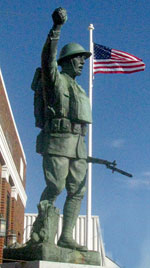 The City Council wasn't as devious as this might seem. The intention to move it had already been announced at a civic club meeting at noon that day. Early the next morning, September 25, "Taps" was played by a lone bugler at the corner of Fourth and Main, but few were present to hear him. I don’t know his name since it wasn’t reported in the article that appeared in the Free-Lance that day. City employees quickly removed our Doughboy and demolished the pedestal. Few witnessed his removal and most residents first learned he'd been removed when they arrived downtown.
The City Council wasn't as devious as this might seem. The intention to move it had already been announced at a civic club meeting at noon that day. Early the next morning, September 25, "Taps" was played by a lone bugler at the corner of Fourth and Main, but few were present to hear him. I don’t know his name since it wasn’t reported in the article that appeared in the Free-Lance that day. City employees quickly removed our Doughboy and demolished the pedestal. Few witnessed his removal and most residents first learned he'd been removed when they arrived downtown. As he was removed, passing motorists yelled derisive remarks at the workmen, but that didn't stop the process. One elderly man told no one in particular, "There's no reason to take it down, but ther's some people who would move Hell this morning if they could." Within minutes, the landmark pictured on postcards sent around the world was gone.
Our Doughboy was taken to the fire station for restoration work to be accomplished before it was erected at its yet to be determined site. A Henryetta era, perhaps its finest, had passed.
Within a few days, a committee selected by Mayor W. R. Stubbs decided the Doughboy would be placed at its current Sixth and Main location at the library as soon as a pedestal could be built. In 1991, a plaque was finally added containing names of 84 young men from the Henryetta area who were killed during WWI, WWII, Korea and Vietnam.
Those living in Henryetta today are used to not seeing our Doughboy in the Fourth and Main intersection (most never saw him there), but to those of us who moved away after living there when he was, it still isn't easy to feel "back home" when we pass that "empty" intersection. And I still wonder what is now the most feared part of the teen age driving test.








